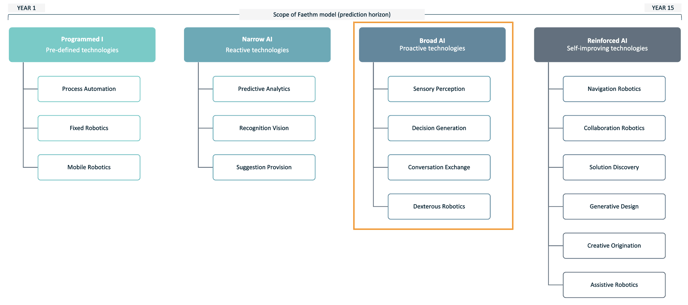Broad AI
Broad Artificial Intelligence technologies are pro-active and require no prompt to act.

Broad AI can self-initiate actions with no human input. These technologies perform unstructured tasks and engage with their environment using perception and sensory processing of external input data.
Sensory Perception
Systems that use ML and sensors to detect and extract meaning from external stimuli.
- Security monitoring systems
- Safety monitoring systems
- Machine vision and motion tracking
For example, Bosch Mobility Solutions’ driver drowsiness detection monitors driver behaviour. It utilises an algorithm and sensors to measure parameters such as driver’s steering behaviour, length of a trip, use of turn signals, and the time of day to calculate the driver’s level of fatigue. If that level exceeds a certain value the driver is notified.
Decision Generation
Systems that use ML to evaluate input data to determine the best course of action.
- Automated diagnosis and personalised medicine
- Prescriptive analytics
- AI finance funds and portfolios
For example, ZTZ Tech Group’s software Prometea produces legal papers on small legal cases such as taxi license disputes. The app writes the case papers and analyses key parameters of a case, presenting a ruling which is then approved or rejected by a judge. It is currently in use in the DA's office in Buenos Aires.
Conversation Exchange
Systems that use ML and sensors to interpret and engage in conversation.
- Smart assistants
- Advanced chatbot
- Social robotics
For example, Google’s technology, ‘Google Duplex’, enables Google Assistant to engage in telephonic conversations. Google demonstrated Assistant calling a salon to book an appointment for a haircut. The conversation is natural with the Assistant understanding questions and responses and the nuances and context of the conversation.
Dexterous Robotics
Robots with flexible functions capable of adapting dynamically using sensors and ML.
- 3D house and materials printing
- Nano-robots
- Advanced manufacturing robotics
For example, restaurant chain Haidilao and Japanese technology giant Panasonic have created a restaurant in Beijing where robots take orders, prepare, and deliver dishes. Robots produce the food and a robot waiter then wheels the dish over to the table for customers to cook in the pot. The system also allows customers to personalise their soup.